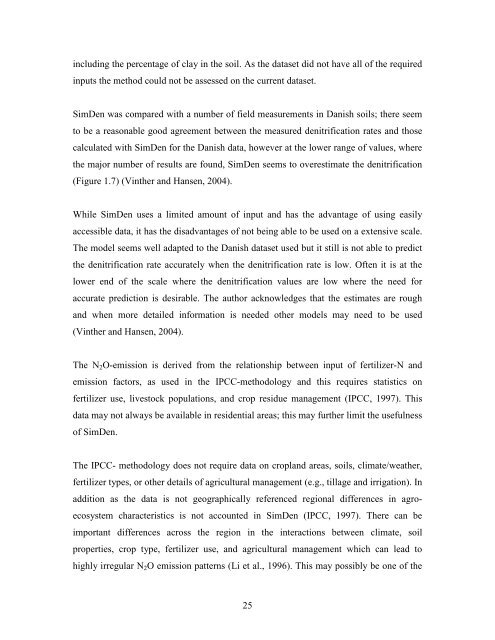THE FLORIDA STATE UNIVERSITY ARTS AND SCIENCES ...
THE FLORIDA STATE UNIVERSITY ARTS AND SCIENCES ...
THE FLORIDA STATE UNIVERSITY ARTS AND SCIENCES ...
You also want an ePaper? Increase the reach of your titles
YUMPU automatically turns print PDFs into web optimized ePapers that Google loves.
including the percentage of clay in the soil. As the dataset did not have all of the required<br />
inputs the method could not be assessed on the current dataset.<br />
SimDen was compared with a number of field measurements in Danish soils; there seem<br />
to be a reasonable good agreement between the measured denitrification rates and those<br />
calculated with SimDen for the Danish data, however at the lower range of values, where<br />
the major number of results are found, SimDen seems to overestimate the denitrification<br />
(Figure 1.7) (Vinther and Hansen, 2004).<br />
While SimDen uses a limited amount of input and has the advantage of using easily<br />
accessible data, it has the disadvantages of not being able to be used on a extensive scale.<br />
The model seems well adapted to the Danish dataset used but it still is not able to predict<br />
the denitrification rate accurately when the denitrification rate is low. Often it is at the<br />
lower end of the scale where the denitrification values are low where the need for<br />
accurate prediction is desirable. The author acknowledges that the estimates are rough<br />
and when more detailed information is needed other models may need to be used<br />
(Vinther and Hansen, 2004).<br />
The N2O-emission is derived from the relationship between input of fertilizer-N and<br />
emission factors, as used in the IPCC-methodology and this requires statistics on<br />
fertilizer use, livestock populations, and crop residue management (IPCC, 1997). This<br />
data may not always be available in residential areas; this may further limit the usefulness<br />
of SimDen.<br />
The IPCC- methodology does not require data on cropland areas, soils, climate/weather,<br />
fertilizer types, or other details of agricultural management (e.g., tillage and irrigation). In<br />
addition as the data is not geographically referenced regional differences in agro-<br />
ecosystem characteristics is not accounted in SimDen (IPCC, 1997). There can be<br />
important differences across the region in the interactions between climate, soil<br />
properties, crop type, fertilizer use, and agricultural management which can lead to<br />
highly irregular N2O emission patterns (Li et al., 1996). This may possibly be one of the<br />
25
















